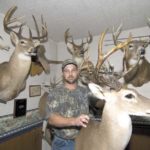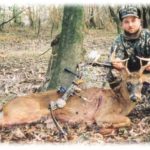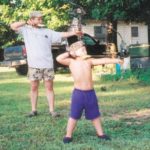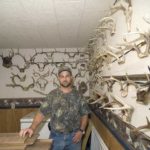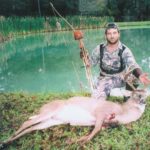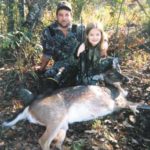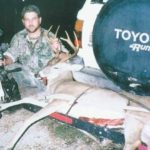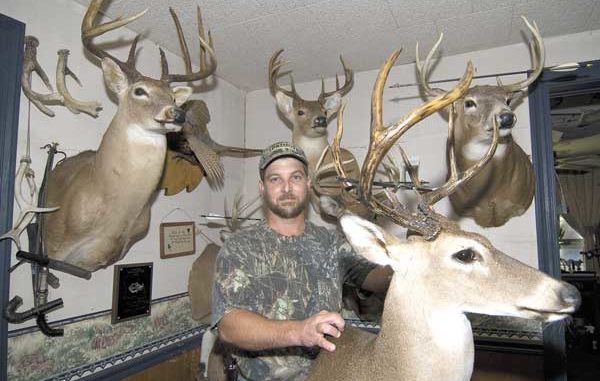
This hunter has killed 147 deer in his 39 years, and almost 90 of those have fallen to well-placed arrows. Follow his tactics, and you can duplicate his success.
Shane Johnson had found a magical hunting spot, and couldn’t wait to set up on it.“There was this scrape that was about 6 feet around,” Johnson said. “Four or five bucks were working this thing, and it really was several different scrapes that had sort of combined.”
He was pumped, and quickly set out a plan.
“I had been taught that deer will come downwind and circle before checking a scrape,” the Singer hunter said. “So I got about 60 yards upwind from the scrape, and I put my back to the scrape.”
Johnson waited for a buck to ease around to his side of the scrape, but he learned a major lesson that day.
“I did what I was taught, but none of that worked,” he said. “I heard something behind me, and I turned and there was an 8-point standing in the middle of the scrape.”
The deer hadn’t circled, but had moved directly to the scrape and was working it over.
The hunter was stunned but excited, especially when the buck finished its business.
“He started walking directly to me,” Johnson said. “It walked right to the tree I was in. I looked between my feet, and I could see the buck through the grill of the stand.”
Johnson readied his bow, deciding quickly to let the deer walk a few feet away before taking his shot.
“That thought lasted about two seconds,” he chuckled. “I bent over and shot him straight down.”
The shot was true, and the hunter had bagged a nice trophy.
Johnson was only about 15 at the time, and that buck was his first deer killed with archery equipment. The hunt, which included a small 50-pound Martin compound bow, changed his life.
“Up until that year, I was a squirrel-killing machine,” he said. “Every year of my life since that hunt, I’ve been deer hunting on the opening day of squirrel season.”
Since then, the 39-year-old has killed dozens of deer. His total as of the beginning of the 2008-09 season stands at 147 (he keeps records, by the way). Eighty-eight of those have fallen during bow season, Johnson said.
“I used to rifle hunt big-time,” he said. “Every year, when gun season opened, I’d put my bow in the closet and pick up my gun.”
During those years, Johnson said he missed the experience of bowhunting that began as a child when he shot bows with his father.
“I have pictures when I was 5 or 6 shooting a bow,” he said.
One of the reasons he kept picking up a gun, however, was that he was so accustomed to filling his six-deer limit each season.
“I was scared I wouldn’t be able to kill deer,” Johnson said. “I was worried that I wouldn’t be able to kill quality bucks, and that’s something I expected every year.”
Finally, he couldn’t take it anymore. He returned to his first love of bowhunting.
“About 10 years ago, I gave up gun hunting,” Johnson said. “Every time I killed a deer with a gun, I’d get mad because I knew I could have killed it with a bow.”
Just to be sure he never again fell off the wagon, he took what many would see as extreme measures to lock himself into archery.
“I not only gave up gun hunting, I sold my hunting rifle so I wouldn’t have the temptation,” Johnson said.
In the past few years, he’s traded his compound bow for a traditional longbow to up the challenge.
The decision required Johnson to modify his expectations, though.
“I made up my mind that if I could kill just one or two deer a year, I would rather do that than kill six with a gun,” he said,
Limits haven’t been a problem, despite the fact he hunts public land.
“I’ve not only killed my six deer every year, I’ve killed bigger deer than I ever did with a gun,” Johnson said. “I’ve killed at least one mountable buck every year for the last 10 years.
“I’ve become a better hunter.”
Such archery accomplishments resulted in Johnson being named Bowhunter of the Year in 2004 by the Bayou State Bowhunters Association.
And the secret to Johnson’s success is found in his all-or-nothing approach to the sport.
“He puts more effort out than anybody I know,” buddy Jamie Vogel said. “He’ll go spend his lunch break to go walking in the woods.”
Vogel said time in the woods with Johnson has been eye-opening.
“He’ll push you,” Vogel said. “He’ll get you up every morning and go scouting. I don’t care if you worked until midnight.”
Johnson has found scouting to be vital.
“Bowhunting is 90 percent scouting and 10 percent hunting,” he said. “I never stop scouting.”
The reason is simple.
“When you find fresh sign, you need to be hunting right now,” Johnson said. “If you find fresh sign and say, ‘I’ll come back Thursday and hunt this,’ the deer have moved on.
“You have to be able to hunt it right then.”
Many hunters key on active game trails, food sources, rubs and scrapes, moving from one to the other depending upon the time of year.
Johnson, however, said his goal is to find all of those components in a small area.
“I hunt what we’ve nicknamed SCARs — scrapes, crap, acorns and rubs,” Johnson said. “If you find all of that in one spot, you better go get your stand right then.”
That means he isn’t targeting a specific deer, but instead is hunting the odds based on the amount of activity in an area.
“People talk about singling out a buck (to hunt), but I think that’s a rarity,” he said. “What you do is you take him as he comes.”
Of course, scrapes and rubs aren’t even worked by bucks during most of the season, but Johnson said they still are indications that deer prefer an area.
As the season begins, Johnson often refers to a computer log he’s built over the years to supplement his pre-season scouting.
“I’ve got more than 150 places I’ve hunted on my computer, and I know every one of them by name,” he said.
That allows him to know where bucks have established scrape lines in the past, and he can then get out and set up a stand where he finds old rubs and active feeding sites in the same area.
In the opening weeks of the season, Johnson focuses on browse such as French mulberry. But he’s keeping a close watch on oak trees during frequent mid-day scouting forays.
“I’m running around with binoculars looking at acorns,” Johnson said. “I’m waiting for the first acorns to fall.
“Once they fall, that’s what the deer will be feeding on.”
Of course, he’s still mindful of the other parts of SCARs — scrapes, crap and rubs.
“It’s not a matter of finding acorns. There are acorns everywhere you go,” Johnson said. “You want to find where all of these things come together.”
When he finds an active feed area around which there is ample deer feces and evidence that deer run scrape or rub lines there during the rut, Johnson sets up his stand and hunts it that afternoon.
These scouting forays could be near his morning stand site, or they could take him miles away.
“I’m constantly going to different places,” Johnson said. “Most people are so tied to a place that they don’t even know what’s on their land. They know the way to their stand, to the gate and back home. They’re trying to get deer to come to where they want them to be. I want to be where the deer want to be.
“It would be torture to put me on a small piece of property and tell me to hunt.”
When the rut begins (normally the last week of November in his area of the state), Johnson said it becomes easier to narrow down his hunting areas as bucks establish active scrapes.
“I’m going to kill at least one good buck between the last week of October and the third week of November,” he said with characteristic confidence. “That’s when you have the ability to really know where bucks are moving.”
Of course, the very nature of chasing deer with archery equipment means that Johnson has to get very close to his prey.
“When I was gun hunting, I would put myself 200 yards away from where I thought the deer would be,” Johnson said. “Bowhunting is a whole different ballgame than gun hunting.
“It’s all a close-in sport.”
Many successful archery hunters are satisfied to get within 50 or 60 yards of deer, but that’s not good enough for Johnson.
“I have the ability to shoot your fist at 60 yards, but I won’t shoot at a deer at 35 yards,” he said.
There are two reasons for this insistence on such intimate quarters.
“I feel like I’m in the wrong tree if that deer passes at 40 yards,” Johnson said. “I feel like I didn’t do my job.”
Equally important is ensuring he doesn’t make a poor shot.
“I feel like there is so much that can go wrong (at longer ranges),” he said. “I would rather let that deer walk than miss it or bugger it up.
“I’ve blood-trailed (deer) many a night when I was younger because I took a stupid shot.”
By allowing those deer that pass by farther away than about 25 yards to walk, Johnson feels he has a chance to adjust and get a better shot. That’s particularly critical with bucks.
“Where I live, if you get a chance to see a good buck, you’d better not blow it,” he said. “If you shoot at a buck and miss or bugger him up, he’s gone. If I let him walk, I at least think I have the chance to get another shot at him.”
Getting bucks in tight is especially important since he’s moved away from shooting compound bows to using a traditional longbow. Now he makes most of his shots at less than 20 yards.
“When I was using a compound bow, my No. 1 goal was making the perfect shot,” Johnson said. “Now that I’m using a traditional bow, it’s even more crucial to get that deer as close as possible.”
To position himself properly, Johnson pays close attention to wind direction.
“I’m a Weather Channel and wind fanatic,” he admitted. “You have to work the wind.”
That’s even with all the high-tech scent-control clothing available today.
“I absolutely don’t believe any of that is close to being a perfect solution,” Johnson said. “I think that deer have the ability to know by scent if you were there six hours ago or if you’re there right now. That buck is still going to pick up your scent, but it fools him into thinking you’re not there right then.”
Instead of relying on carbon-impregnated clothing, Johnson simply does his best to ensure he’s downwind of where he expects a deer to appear.
“The wind is everything,” he said.
Johnson primarily hunts Ft. Polk Wildlife Management Area, so he has to tote his stand into the woods. That allows him to adjust to suit the wind.
His favorite is a lock-on made by Ameristep, which he is able to set up quickly and quietly using the company’s NT Rapid Rails strap-on ladder.
The key is being extremely quiet when setting up, especially if he walks in before daylight.
“The deer I’m going to see at 8 a.m. is right there, and he can still hear you even though it’s dark when you set up,” Johnson said. “So you want to keep the noise down to a minimum.”
To allow any deer that do hear him to settle down, Johnson makes a point of being in the woods very early.
“It’s not uncommon for me to be settled in my stand a smooth 45 minutes to an hour before it even thinks about breaking daylight,” he said.
However, he has perfected the ability to set up very quietly even during the daylight hours.
“I’ve actually climbed a tree with a lock-on and when I put my butt on the seat I was looking at deer inside of 50 yards that didn’t know I was in the woods,” Johnson said.
If he sees a deer that’s farther away than about 20 to 25 yards, Johnson just moves for the next hunt.
“The whole secret to killing deer with a bow and arrow is figuring out how to get that joker right there,” Johnson said. “Ten yards makes all the difference in the world.”
This reality has refined his skills and forced him to become a much better hunter.
“Once you learn how to find deer and kill them naturally (without bait or green patches), you can kill deer anywhere in the United States,” Johnson said.
And when everything falls into place and a shot is taken on a deer from mere steps away, Johnson said all the work is worth it.
“It’s so much of an accomplishment,” he said.
However, the accomplished hunter said even all the time spent in target practice and scouring the woods is not fully responsible for his success.
“I truly believe there’s not one deer I’ve killed that wasn’t a gift from God,” Johnson said. “I feel like I do my part, but I feel like God has blessed my effort.”
